Source: Michigan News
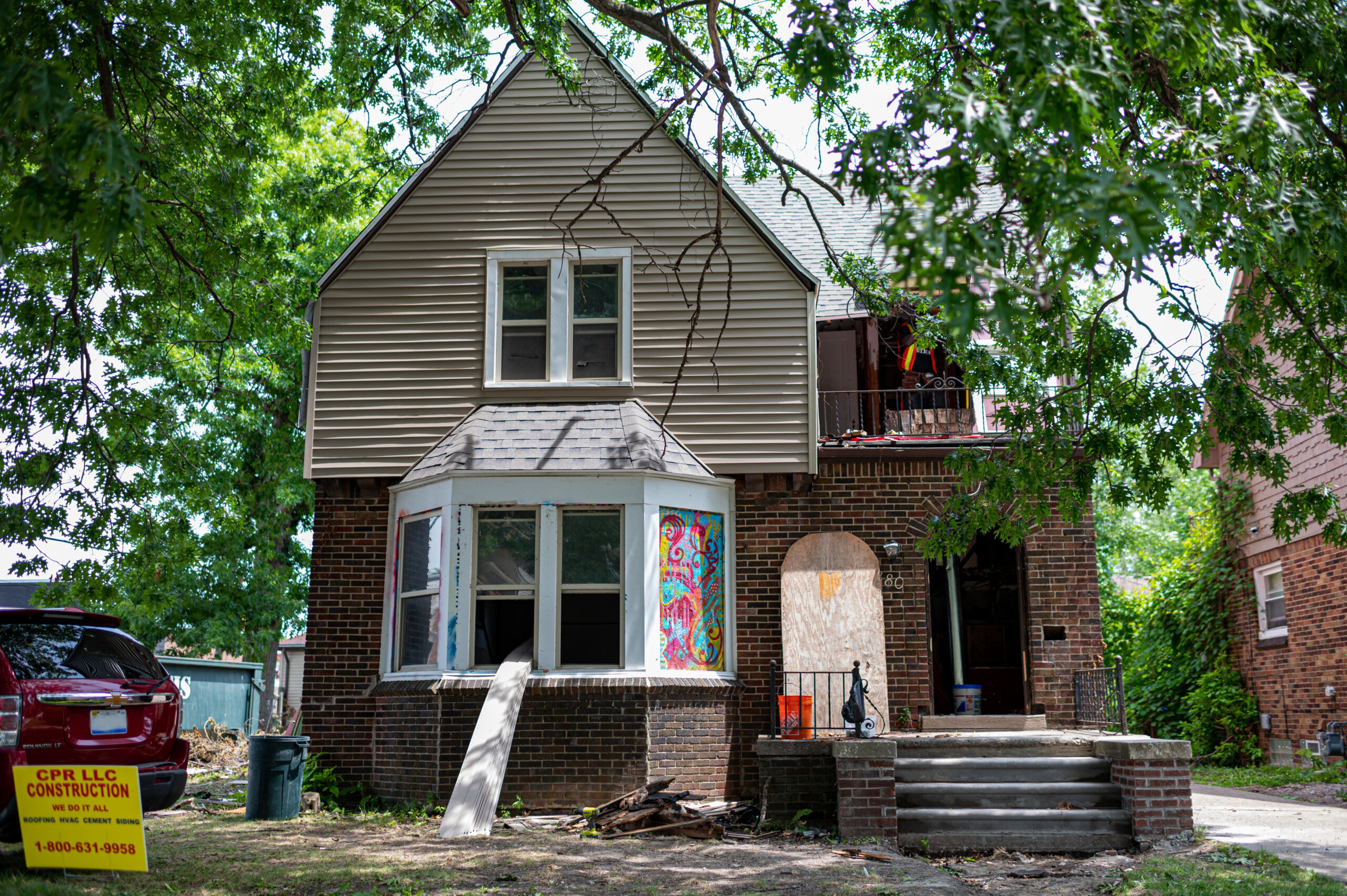
Rehabbing homes in Detroit’s MorningSide neighborhood is part of stabilizing the neighborhood. Credit: Eric Bronson
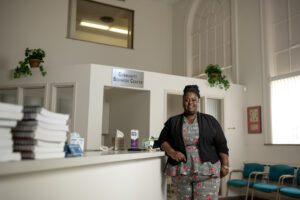
Jowana Jackson, a program manager at U-SNAP-BAC, a nonprofit housing organization, credits faculty and students from U-M for helping the community create tools and gain access to resources that helped stabilize it. Credit: Eric Bronson
More Info
Jowana Jackson wants to walk outside her house on Detroit’s east side and see what anyone else would desire—the beauty of a strong, healthy, thriving community.
MorningSide, a neighborhood that’s 1.5 square miles and borders East English Village and Grosse Pointe, has many stately brick homes built for times when families were larger. Like much of the area, it was once French ribbon farms that stretched to the Detroit River before being developed into subdivisions in the 1920s.
There was a time not long ago when people were fearful as the foreclosure crisis swept through. Between 2000 and 2010, the population dwindled by 27%, owner occupancy fell to 60% from 65%, more than 20% of properties were vacant lots, and many houses that remained were in need of renovations or repairs, according to a University of Michigan study.
Jackson, a program manager at U-SNAP-BAC, a nonprofit housing organization, credits faculty and students from U-M for helping the community create tools and gain access to resources that helped stabilize it.
“The students helped us put on tax foreclosure meetings, helped us leaflet the neighborhood, collected data and did a lot of research,” she said. “With the data, I think the University of Michigan helped put the spotlight on a lot of the troubles. It gained attention from other agencies, entities and philanthropists to help put money into the city and help people save their homes through property tax exemption.”

Margaret Dewar, professor emerita of urban and regional planning in the A. Alfred Taubman College of Architecture and Urban Planning, began working with the MorningSide community in 1994. Twenty plus years and dozens of student teams under Dewar’s leadership have had a major impact on MorningSide. Credit: Eric Bronson
Margaret Dewar, professor emerita of urban and regional planning at the Taubman College of Architecture and Urban Planning, began working with the MorningSide community in 1994. Even then, she said, the MorningSide Community Organization was very active in working to fix up the neighborhood: “And just walking around the neighborhood, you could hear hammers, people were renovating. And so how could that be supported and reinforced was the question.”
Tragedy unfolds
Dewar started bringing U-M urban planning students to look at various issues and look for solutions alongside community members. Dozens of student teams under Dewar’s leadership have had a major impact on MorningSide.
A critical point in the relationship came as the foreclosure crisis took hold and long-time community partner Linda Smith, director of U-SNAP-BAC, shared her frustration that she was seeing 25 years of her work go down the drain in a matter of months.
“And she wasn’t asking for any intervention from me or anything. She’s just sharing this tragedy unfolding. And I said, well, what can we do about it?” Dewar said. “And so I worked with students on a plan about what to do to combat this tidal wave of mortgage and tax foreclosures.”
In Dewar’s advanced urban planning course, students would work with community partners in Detroit neighborhoods to strengthen neighborhoods or to advance whatever goals they had, like reinforcing parks or commercial areas as part of their capstone course.
For the 2015 project, they partnered with U-SNAP-BAC, Habitat for Humanity, Detroit Future City, the city of Detroit and other organizations doing work in the area at that time to help stop the housing free fall.
“We were working to figure out what was the situation first of all, and then what could be done? Meaning what could they do? What could they take on?” Dewar said. “So we were laying out the plan with their extensive input and involvement. So they were committed to it.”
The plan they came up with laid out options for dealing with the tax foreclosures, for renovating houses, for reusing vacant land. And then they helped to implement ideas.
“For example, the students participated in property tax exemption and property tax foreclosure prevention workshops that United Community Housing Coalition was organizing in MorningSide,” Dewar said. “And so they worked with a lot of residents to show them how they could reduce their taxes and how they could get exemption from taxes due to poverty. And they also worked with the mayor’s office to propose initiatives that could reduce property taxes or make it easier for people to pay.
“Residents told the students that if they could pay little bills along the way, instead of this huge bill they got in the summer and winter, then they thought they could keep up better. And so the students suggested kiosks where people could use cash to pay in the neighborhoods, so they didn’t have to go downtown to the city hall to pay.”
MorningSide taught us so much
The students also laid out how to get the most impact from homes being renovated to give residents confidence that the neighborhood had a future so that they wanted to stay. U-SNAP-BAC and the neighborhood association wrote a proposal to get funding that would implement some of the students’ ideas in a larger area of vacant land on the west side of the neighborhood. They received the grant and have transformed that once dumped-on, overgrown, vacant expanse into a community park where children play.
Dewar is quick to point out that successes like these are never just the university working alone. These projects are only possible, she said, “because we do this with the energetic, inspired people in the city.”
The result was the Stabilizing MorningSide plan. It built upon the assets of the MorningSide neighborhood to strengthen its housing market and once again make it a neighborhood of choice.
Some U-M students working on the project already knew Detroit, but many didn’t. Several became so fascinated by the city and what was possible, they went on to work for the city or with a nonprofit that serves Detroit in some way. The course provides students with an understanding of the city that goes way beyond what’s portrayed in the news, Dewar said.
“I feel as if MorningSide has taught our students so much, and so we just have to make sure that MorningSide gets just as much or more back,” she said. “And so we’re always really careful to work with people … not to impose anything on people, but to partner with them.”

Linda Smith, executive director of U-SNAP-BAC. Credit: Eric Bronson
Linda Smith, executive director of U-SNAP-BAC, said she’s enjoyed working with Dewar’s students—many who went on to big jobs in the city. For example, she remembers working with Saskia Thompson, former director of the Detroit Land Bank, and Rob Linn, who is the director of inventory at the Detroit Land Bank.
“They all came through a group of urban planning students who wanted to get involved in Detroit,” Smith said. “Sometimes, I’ll get an email and they say, ‘Thank you. Guess what I’m doing?’ because when you come here with me, you learn. You get the experience.”
Smith would take the students out into the community with her to see how she works with the community. In exchange, the organization received project time from the students that provided data collection and information Smith could take to funders to finance projects.
“We call them spark plugs here,” she said. “Without the students, we could not stabilize MorningSide for the work that was done. As I was looking at the report, I started thinking about the number of funders who helped us with grants. That would not have happened if we hadn’t had the research.”
The gravity of the situation
Evan Markarian was one of the students who worked with Smith on the Stabilizing MorningSide report. He’s now a senior housing consultant for Detroit’s Bridging Neighborhoods Program. It renovates properties in the Detroit Land Bank inventory and offers those homes to people who own homes that are affected by the Gordie Howe International Bridge project.
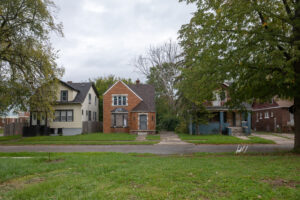
MorningSide, on Detroit’s east side, is known for its interesting architecture including many brick Tudor style houses.
Credit: Rebecca Cook
Markarian said a big part of the MorningSide project involved analyzing the Detroit Land Bank’s inventory of homes and lots in the neighborhood and developing ideas to market the properties. Students went block by block looking at the ownership of each parcel, which is critical for tagging properties falling into disrepair and causing problems for neighbors.
“It’s just an incredible scale of impact of the tax foreclosure, the crisis, and that’s why I was really drawn to the project because it was—at that time, that was a No. 1 thing going on in Detroit,” he said. “People were being put out of their homes for their property taxes, which we know now, in a lot of cases, were overassessed. This was after mortgage foreclosures, so there was this second wave that was hitting the neighborhood.”
Markarian remembered helping out at a tax foreclosure prevention workshop at U-SNAP-BAC, where he was working with a man who had lived in his home for 50 years. The elderly man just needed help with an online form so he could avoid losing his house.
“It was amazing to me that this is how the system works or doesn’t work for people,” he said.
Markarian worked on a home renovation guide and other resource material for residents, in addition to other research. And he credits Dewar with leading students in a way that helped them gain critical perspective in their forays outside the bubble of Ann Arbor.
“She was like a guiding light kind of seeing us through the gravity of the situation because when you think about how much of that neighborhood was affected by foreclosures, we were entering a war zone in a weird way, like a fiscal war zone where people were pushed out of their homes,” he said. “She pushed for that level of representativeness, like representing who we were trying to plan for, to advocate for, and also conveying that this wasn’t something we were going to solve in the course of a capstone.”
Markarian, who grew up in suburban Detroit, said that even though he was cognizant of the incremental nature of the project, Dewar made the students feel like the work could have an impact on its own. And that’s certainly been the case.
Jackson was working with U-SNAP-BAC through AmeriCorps in 2015 when Markarian and other U-M students worked on the Stabilizing MorningSide report. Six years later, she’s seeing more bright spots as empty lots are given purpose and neglected homes are being repaired in the close-knit community with an active block club. Home values are up as well—with houses that typically sold for $20,000 to $30,000 during the slump going for over $100,000, she said.
“We experienced some lows for a moment, but I feel like we’re just coming back. You see the parks going up, just seeing the changes,” Jackson said. “Since the University of Michigan came to the neighborhood, I believe it greatly impacted not only myself as a homeowner, but the neighborhood as a whole. All the work that’s being done on Warren, you’re seeing East Warren coming back.
“So anytime you see your main thoroughfares come back, that’s definitely a huge thing. And we have properties available, so anyone who wants to come to MorningSide, come on right to MorningSide.”
An area on the rise
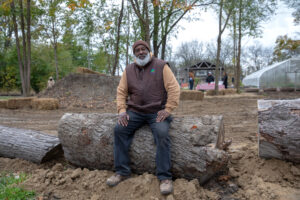
Aaron Smith, founder of Motor City Grounds Crew, moved his business to MorningSide two years ago. Credit: Rebecca Cook
Aaron Smith, founder of Motor City Grounds Crew, moved his business to MorningSide two years ago. He’s located at Warren Avenue and Balfour Road and has been struck by the community’s “great pride.”
He cleaned up the space behind his company offices—seven vacant parcels that had become a dumping ground overgrown with vegetation.
“We’ve cleaned it up. We’ve removed several trees and our vision is to develop it as a space for the community to come for gatherings and sanctuary and enjoy the ambiance of being here in the neighborhood,” he said.
Smith also is a member of the MorningSide Community Organization where its president, Eric Dueweke, a retired lecturer at U-M’s Taubman College, encouraged him to get involved.
“Eric is a person who was one of the inspirations that said, ‘Hey, Aaron, here’s a building that maybe your company can acquire.’ I checked into it. And that was great,” Smith said. “‘Hey, Aaron, what do you think about your organization acquiring these vacant properties?’ And I was all about that.'”
“The MorningSide community is one of great pride. And we’ve been here two years as a business establishment, and I’m loving it as our home.”
Zelda Anderson, a longtime MorningSide resident, block club secretary, precinct delegate and neighborhood advocate, has lived in the neighborhood for more than 20 years.
She said when she moved to the neighborhood, it was a vibrant area with lots of businesses on main roads such as Alter Road and East Warren Avenue. The bulk of the homes are unique, many 100 years old with fine plaster walls and details.
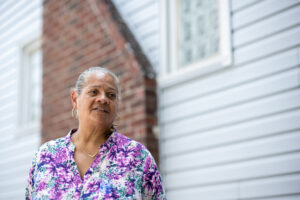
Zelda Anderson, a longtime MorningSide resident and neighborhood advocate, credits U-M for helping find owners of homes so they could be held responsible for fixing them up. Credit: Eric Bronson.
“MorningSide is an area that is on the rise,” Anderson said. “If you want to live in MorningSide, I think it’s an excellent idea because there’s a lot of movement, a lot of rehab, a lot of homes that people are purchasing, a lot of things are happening now, redevelopment in the business district.”
She was part of the neighborhood focus group that worked with U-M students on the stabilization report. One question the group worked on was what could be done with vacant land, vacant houses and blight issues. They needed help finding out who owned many of the houses that were in disrepair so the city could tag them for improvements.
“The project went very well,” Anderson said. “U-M was instrumental in getting some of these homes here tagged. They weren’t land bank-owned at the time. They were private owners. As a result, they’re doing something. They’re rehabbing them because some of them were just sitting there with absolutely no movement, nothing. Nobody knew who the owners were or who to contact. I’m most grateful for U-M going the extra mile to do that.”


